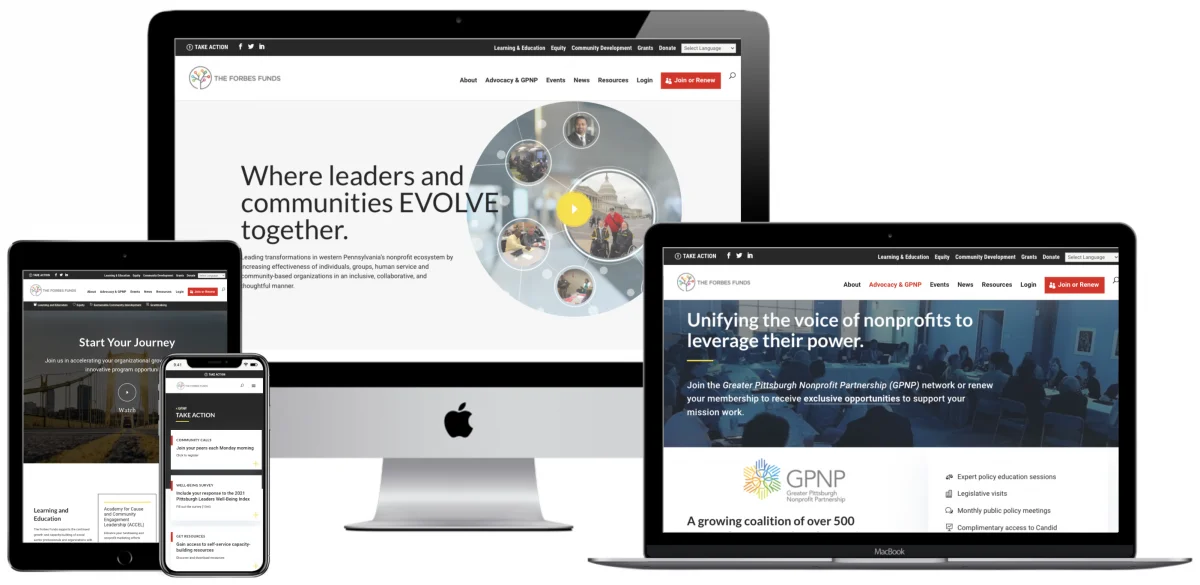The demand for up-to-date everything can be overwhelming. Now organizations can’t just be organizations, they have to be “influencers,” “social media gurus,” “web developers,” and so much more. It may feel a little overwhelming at times. Whether you have a weekly newsletter that you promote daily on social media or if you’re a little less active in the digital space, the value of maintaining an up-to-date website cannot be overstated.
As tech has evolved over the years, a website becomes outdated every two-and-a-half to three years, even if you post fresh content regularly. Unfortunately, newsletters or social media are not an alternative to making important information to customers who are purportedly at the forefront of the mission.
A website is often the first touchpoint between your customers or audience and a business in the online realm, functioning as a virtual storefront that shapes perceptions and facilitates interactions. When a website becomes dilapidated, there is a need for a mobile-first, engaging, and interactive website that will help reach, interact, and respond to your community’s needs.
So, whether you’re selling products, or providing a service, an up-to-date website can let stakeholders know what you do, how you can help them, or how they can help you, giving relevant information, organized in a logical, easy-to-navigate format.
Let’s explore the multifaceted importance of keeping websites current, delving into user experience, search engine optimization, security, brand credibility, and the overarching need for a competitive edge in the digital arena.
1) Enhanced user experience: your very own digital welcome mat
Let’s imagine you’ve heard of an organization. Maybe you see them via a LinkedIn ad or they do good in the community and you want to find out more. But you go to their website and the page loads slowly and text is all over the page, overlapping with other elements, the hamburger menu barely works without glitches, and it’s difficult to click links to go to the pages you want to read. Would you keep going? You want to interact with this business. You want to find out information but the mobile version of their website barely works. You may go to your desktop and see if the experience is better or you may not. You may just give up. If you work for an organization, have you checked out your company’s website? How does it work? Does it provide your clients and customers with the sort of experience they want and need? This example may be extreme and your website may have been updated in the last few years, but is all that content relevant and helpful?
User experience (UX) is at the forefront of the digital realm, and an up-to-date website plays a pivotal role in ensuring a positive interaction. When visitors encounter a website, they form rapid judgments about its credibility and reliability. Outdated designs, slow loading times, bad mobile responsiveness (i.e. the design looks great on a desktop/laptop but terrible on mobile where most of your users will originate), and broken links can contribute to a frustrating experience, prompting users to abandon the site.
Here’s a piece we wrote about how UX affects your bottom line and you can check out the case study of the Bicycle Coalition and how a brand refresh grew their membership.
Up-to-date websites are more likely to be visually appealing, responsive across various devices, and equipped with the latest usability features. Users navigating such sites experience seamless interactions, fostering a positive impression and encouraging prolonged engagement. The value of an up-to-date website lies not only in attracting visitors but also in keeping them engaged and satisfied.
We have a host of content about UX, design thinking, and branding. But the bottom line is, when customers come to your website you want them to understand what you do, how to navigate your website, how to find the information they want, and you want that information to be relevant and timely. With an outdated website, you will most definitely not be providing them with a seamless experience and that may mean lost customers.
2) Search engine optimization: the path to visibility
The dynamic nature of search engine algorithms requires constant adaptation for websites to maintain or improve their visibility. Search engines like Google favor fresh, relevant content when determining search rankings. Regular updates to website content, blog posts, and meta tags signal to search engines that the site is active and valuable to users. People who work in the digital space designing websites will understand what the latest algorithm update from Google means to websites and which elements are more important than before, so keeping your website updated, will mean you’re likely to maintain your organic search rankings and keep visibility but if your website is outdated, you’re unlikely to rank highly in the first place.
The significance of SEO in driving organic traffic cannot be overstated. An up-to-date website that adheres to SEO best practices has a higher likelihood of ranking well in search engine results, ensuring that it remains discoverable by potential visitors. This visibility is crucial for attracting new audiences, expanding reach, and ultimately, achieving business objectives.
3) Security and functionality: safeguarding your digital fortresses
Cybersecurity is an ever-growing concern in the digital age, and outdated websites are particularly vulnerable to security threats. Security breaches can lead to unauthorized access, data leaks, and damage to a brand’s reputation. Regular updates to a website’s software, plugins, and security protocols are essential for addressing vulnerabilities and preventing exploitation by malicious entities.
Certain CMS platforms like Joomla or WordPress are created using plugins, widgets, and modules. Web support and popular plugins are regularly updated to improve performance and compatibility but that means when one widget is updated, it may impact others and “break” bits of the website, so a routine update not only fixes security patches but also ensures all of your websites work smoothly.
The value of an up-to-date website in terms of security extends beyond protecting sensitive data. It also contributes to building trust with users. A secure website reassures visitors that their information is handled responsibly, fostering a sense of confidence in the brand and its digital practices.
Furthermore, major initiatives of a new website should include a mobile-first design, an easier-to-use interface, ADA compliance with WCAG, multilingual support, and improved features to support missions in maximizing their impact.
4) Brand credibility: shaping digital trust
A website serves as a crucial touchpoint for brand interactions. An outdated website can convey a sense of neglect, potentially eroding trust in the brand’s professionalism and commitment. Conversely, an up-to-date website reflects a brand’s dedication to staying current and providing a positive user experience.
Online reputation plays a significant role in consumer decisions, thus maintaining a credible digital presence is paramount. User reviews, social media mentions, and overall online sentiment are influenced by the perceived credibility of a website. A current website becomes a cornerstone in building and preserving digital trust, contributing to a positive brand image.
5) Competitive edge: staying ahead in the digital race
The digital landscape is competitive, and businesses that fail to adapt risk falling behind. A current, fresh website positions a business as forward-thinking and responsive to industry changes. It enables organizations to showcase the latest products, services, and innovations, setting them apart from competitors with stagnant digital presences.
Moreover, tools like analytics platforms provide insights into user behavior and preferences, allowing businesses to refine their strategies based on real-time data. An up-to-date website, coupled with data-driven decision-making, provides a competitive edge by enabling businesses to anticipate market trends and align their offerings with evolving consumer demands.
The takeaways
It may seem overwhelming to think you have to update your website regularly, but a brand refresh may mean simplifying your design. You may go from a confusing twenty-page design to five easy-to-navigate pages, which will mean cheaper future refresh costs. A redesign can help you understand how your users want to use your website, what information they want – and how easily they can find it. The imperative to keep websites current is clear.
Businesses and individuals alike must recognize that a website is not a static entity but a dynamic tool that requires continuous attention and adaptation. The digital landscape rewards those who prioritize staying current, ensuring that their virtual presence remains a vibrant and effective reflection of their objectives and values.
The successful launch of a new website platform will position your organization as embracing the latest technological innovations rooted in a human-centered approach on launch and well into the future. If you need a website refresh to keep your website current, get in touch with Key Medium today.

Elaine Frieman holds a Master’s Degree and is a UK-based professional editor, educational writer, and former marketing agency content writer where she wrote articles for disparate clients using SEO best practice. She enjoys reading, writing, walking in the countryside, traveling, spending time with other people’s cats, and going for afternoon tea.

